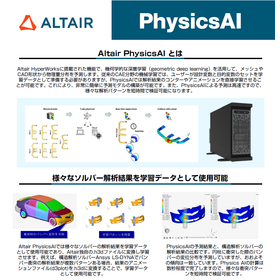The analytical model for calculating electromagnetic force in the plunger model was a three-dimensional model.
The calculation of electromagnetic force in the plunger model was performed for the plunger model proposed by the Institute of Electrical Engineers for electromagnetic force verification, where the electromagnetic force acting on the center pole and the magnetic flux density of each part of the model were calculated when current was passed through the coil. For more details, please download the catalog.
Inquire About This Product
basic information
【Features】 ○ The model is axially symmetric in both the X-axis and Y-axis directions. → Therefore, the actual analysis model is a 1/4 model as shown in Figure 2, due to its symmetry. ○ The total number of nodes in the model is 31,824, and the total number of elements is 28,900. ○ The module used for the analysis calculation is PHOTO-EDDY. ○ Material properties: → Air relative permeability: 1, Coil relative permeability: 1, Magnetic material relative permeability: 1000. ○ Analysis conditions: → Coil current: 1000AT. ○ Analysis results: → Electromagnetic force acting on the center pole: 8.22N. The measured value presented by the Institute of Electrical Engineers is 8.23N, so the error is 0.12%, indicating that a very accurate value has been obtained. ● For more details, please contact us or download the catalog.
Price information
Please contact us.
Delivery Time
※Please contact us.
Applications/Examples of results
For more details, please refer to the catalog or contact us.
catalog(1)
Download All CatalogsCompany information
At Photon, we are developing "electromagnetic field analysis software" that models and simulates products and components utilizing electromagnetic phenomena on a computer. In traditional design and development environments, the process has primarily revolved around trial and error through prototyping based on the experience of engineers and experiments with prototypes. However, conducting experiments using actual prototypes and analyzing the results requires significant time and cost. Moving forward, transitioning from an experimental and prototyping-based approach to an analysis-based design approach will be a crucial challenge for improving productivity, and establishing simulation technology as the core of analysis-based design techniques will be essential. In this context, Photon is developing and providing "analysis software" focusing on electromagnetic fields, as well as heat, vibration, and sound fields. By utilizing Photon's software, efficient development and design of various industrial products can be achieved. In this way, Photon aims to support users in reducing the number of prototypes, lowering development costs, and shortening development periods in their manufacturing environments, ultimately enhancing their competitiveness.


![[Case Study 8] Product Catalog for Electromagnetic Force Calculation in Plunger Model](https://image.mono.ipros.com/public/catalog/image_generated/01/522/223753/223753_IPROS954894782435920814_1.jpg?w=120&h=170)

![[Analysis Case] Electromechanical Coupled Analysis of Cylindrical Piezoelectric Elements](https://image.mono.ipros.com/public/product/image/c82/2000766440/IPROS89777163338614210402.png?w=280&h=280)
![[Analysis Case] Frequency Response Dynamic Magnetic Field Analysis of Magnetic Shielding](https://image.mono.ipros.com/public/product/image/68b/2000763926/IPROS02180885106606877203.png?w=280&h=280)
![[Analysis Case] Predicting the magnetization distribution within a plastic magnet from measurement data.](https://image.mono.ipros.com/public/product/image/0fb/2000766424/IPROS84954300516761741480.png?w=280&h=280)




![SOLIDWORKS 2026 New Features Seminar [Free Participation]](https://image.mono.ipros.com/public/default/object/noimage_l.gif?w=280&h=280)